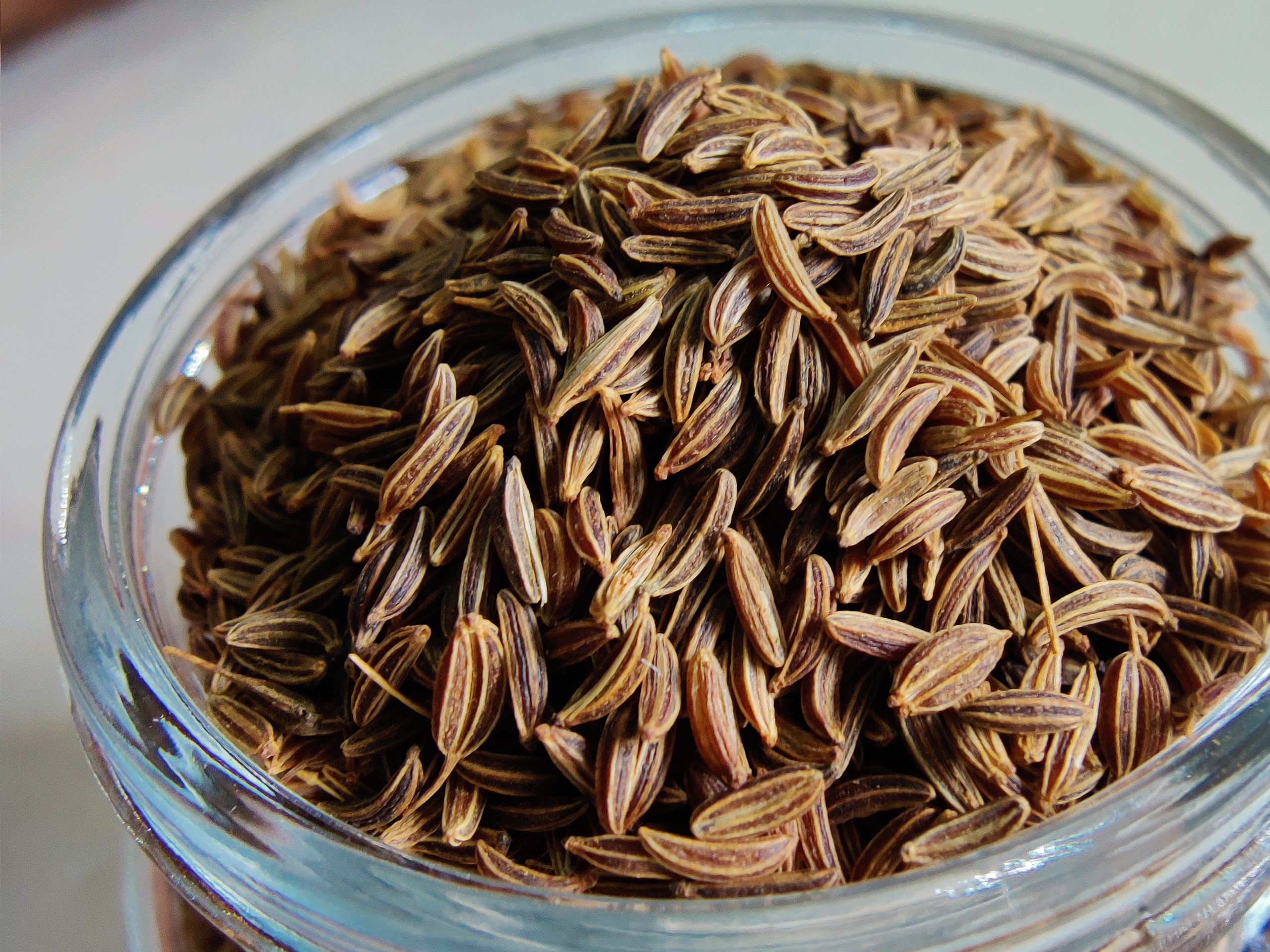Caraway Seeds Carum carvi in Bulk packaging Shipped in 20″ FCL Container
Login to view prices
Common name: Caraway
Latin name: Carum carvi L.
Family: Apiaceae (Umbelliferae)
Other names: Engl.: caraway, annual caraway, caraway seed. Deu.: Kümmel, Gemeiner Kümmel, Wiesen-Kümmel. Suom.: kumina. Sven.: kummin. Fran.: anis des vosges, carvi, cumin des prés
Botanical Origin:
Common name: Caraway
Latin name: Carum carvi L.
Family: Apiaceae (Umbelliferae)
Other names: Engl.: caraway, annual caraway, caraway seed. Deu.: Kümmel, Gemeiner Kümmel, Wiesen-Kümmel. Suom.: kumina. Sven.: kummin. Fran.: anis des vosges, carvi, cumin des prés
Description:
Caraway, Carum carvi L., is a slender annual or biennial herb native to Asia Minor and Europe and naturalized in North America. The plant, reaching a height of approximately one meter, has long been prized as a flavoring agent or condiment. Caraway fruits (commonly called seeds) are actually the mericarps of ripe fruit borne in compound umbels.
In the seedling year, biennial plants resemble carrots, growing about 20 cm (8 inches) tall, with finely divided leaves and a long taproot. By the second year, 60 to 90 cm (2 – 3 foot) stalks develop, topped by umbels with pink or white flowers. These produce the seed, which is used as a spice. Plants that produce flowers and seed will die. Only plants that have not yet flowered will produce seed the following year.
The crescent-shaped seeds are about 2 mm long, curved and tapered at each end and have 5 pale ridges. Buyers look for a dark brown color in the valley between each ridge.
The fruits, commercially called seeds, are oblong, laterally compressed, dark brown, which ripen in August during the second year of growth. They possess a characteristic, aromatic odor, and a warm sweetish, spicy taste. For this reason, the dried seed is widely employed for flavoring bread, cakes, confectionery, cheeses, and all kinds of food products. Odor and flavor of the seed are due to the essential oil
Principal production areas are located in Egypt, the Netherlands (Holland), Poland, Spain, Turkey, the USSR, the United States, and Morocco.
Range & Habitat:
Caraway (Carum carvi L.) is native to Europe, western Asia and northern Africa.
Caraway can be either an annual or biennial plant.
It prefers a well-drained soil high in organic matter, but will grow well in many soil types. Caraway responds well to irrigation and can stand some light flooding. Under drought conditions, it will not die, but yields will be severely reduced. For this reason, shallow sandy soils with low moisture holding capacity should be avoided. Because it is a poor competitor with weeds, caraway needs to be grown on clean land to increase the chance of success.
Caraway is adapted to temperate or subtropical dry summer climates. It has an optimum growing temperature of 13° C with a minimum growing temperature of 4° C. It is day-neutral, so length of daylight has no effect on maturity or yield. It will grow on a wide range of soil textures, but prefers well-drained soils with an optimum pH of 6.5 (range 5.8 – 7.5). A high level of fertility is required, and caraway’s tolerance to salinity is relatively low.
Planting & Cultivation:
- Seeding:
Since maturity requires about 15 months, biennial caraway is generally seeded with a nurse crop e.g. peas, mustard, beans, white clover, and flax serve as cover crops. To reduce competition to the caraway crop, the nurse crop should be seeded at half to two thirds the normal rate. If there is too much competition, the caraway plant may not have enough growth to flower and set seed. Crops that produce heavy vegetative growth should not be used as nurse crops.
The biennial caraway is usually intercropped with vegetables that are harvested the first year. Caraway is typically seeded at the end of March or beginning of April, the plant germinate (two to three weeks) and blossoms during the following year, in May to in mid-June.
The seeding rate for caraway is 6 kg (12 lbs) per acre (13 kg/ha). Seeding depth should be from 1.3 to 2.5 cm (1/2 -1 inch). Caraway can be broadcast and then harrowed in, or a grain drill with a grass seeder attachment can be used. An air seeder with good depth control will also work well.
Caraway plants with small roots (less than 13 mm (½ inch) in diameter) at the start of the second growing season usually do not produce seed. They remain vegetative through the growing season and produce seed the following year. Caraway plants with larger roots (greater than 13 mm (½ inch) in diameter) at the start of the growing season will usually flower and produce seed.
Because caraway is slow to germinate (two to three weeks), good weed management is important.
- Fertilization:
Caraway does not require special fertilizing in the seedling year; however, a highly fertile soil will result in better yields. A balanced fertility program, including nitrogen, phosphate, potassium, sulfur and micronutrients, is recommended. This program should be implemented on the basis of a soil test.
In the seedling year, use your regular fertilizer program on the nurse crop, making sure there are sufficient nutrients for the caraway crop as well as for the cover crop. An application of nitrogen, 18 to 27 kg (40 – 60 lb) per acre (45 – 67 kg/ha), after the nurse crop has been harvested or early in the spring of the following year is essential for continued good yields.
Harvesting and Preparing for the Market:
Harvesting begins when the seed color changes to brown, as shattering is a problem with late harvest.
At present, caraway shatters very easily when fully ripe, but work is underway to develop varieties slightly more resistant to shattering. To reduce shattering, swath in the early morning when dew is still on the plants.
Seed can be harvested with a regular field swather and combine (threshing machine). The crop should be swathed when three quarter of the seeds have turned dark brown. Some producers leave a high swath stubble and use a swath roller to anchor the swath. Caraway threshes easily. Combine when seed moisture content is 10 per cent or less. Adjust the combine to keep seed loss to a minimum and prevent damage to the seed.
Cylinder speed and concave clearance of the machine should be similar to settings used for canola and mustard. Seed moisture for storage should be below 10 per cent, or bin aeration will be required. Many buyers demand that seed be at 9 per cent before they will take delivery.
Storage:
Since caraway oil is very volatile, the seed needs to cure during storage. Natural air drying (aeration) is necessary for curing. Hot air drying should be avoided if possible.
Seed needs to be checked regularly during storage. Storing for longer than a year is not recommended. Buyers prefer a fresh product as carvone levels decrease with age.
Weed seeds and other foreign material should be cleaned from the sample as soon as possible to facilitate bin aeration.
Yield:
Seed yields range from a hundred or so kilograms per acre the first year to over 500 kg (1,000 lb) per acre (1,120 kg/ha) for the next year or two.
In Egypt the seed yield is 750-1000 kg/acre
Yield of oil: the essential oil content of Dutch caraway seed ranges from 3 to 6 % (≈ 4%), however the Egyptian caraway oil has a volatile oil content of 2 to 3%.
It is said that sunny, dry weather during seed maturation diminishes the content of oil, but the oil is then high in carvone and correspondingly low in terpenes. On the other hand, cool, damp weather increases the oil content, but the oil is low in carvone and other oxygenated compounds. This variation might be caused by photochemical forces which transform trpenes into oxygenated compounds. It is also possible that during sunny, hot weather, some of the more volatile oil constituents, and particularly the terpenes, evaporate, so that the content of the less volatile, oxygenated compounds increases.
Export Markets:
We export our products to many countries all over the world. USA, France, Germany, China, Malaysia, Algeria, Morocco, Indonesia…etc
Quotation:
- Incoterms: FOB Egypt or China
- Quantity: one 20″ FCL Container Minimum
- Specification: 100% natural and Pure quality
- Documentation: COA, MSDS, TDS, GC Peaks
- Packaging: Bulk Packaging
- Payment terms: TT in advance to Our bank account
- Lead time: Shipping through 10 days from receipt of the payment.
- Sea Shipping Time: 35 days
- Air shipping time: 10 days
Quality Certificates:
- ISO 9001-2015
- ISO 22000-2005
- GMP accredited by AQC Middle East FZE
- KOSHER Certificate
- Halal Certificate
- ORGANIC Certificate accredited by CERES GmbH Germany
- NOP Certificate accredited by CERES GmbH Germany
- Egyptian Ministry of Health Permission
Contact us please to receive other supporting documents for our Oils :
- COA
- MSDS
- TDS
Branding Services
We also can do customized packaging for you to pack whatever size you like. We can help in designing labels, selecting good packets or bags. We deliver integrated solutions under your brand..
Organically Certified product Available upon request
Additional information
| Weight | 12000 kg |
|---|---|
| Dimensions | 610 × 244 × 259 cm |
| Country of Origin | Egypt |
| Herbs & Spices Purity | 97%, 98%, 99% |
| Ship from | Egypt |
| Herbs Packaging | PE bags 25 Kg, PE Bags 50 kg, Paper Bag 25 kg, Paper Bag 50 kg |
| Cultivation Type | Organic, Conventional |
| HS Code | 09109990 |
| Custom Branding & Packaging | Yes, OEM Custom banding, designing and packaging are available for that product |
| Herbal OEM Packaging | Kraft Bag, Kraft Bag with transparent window, Kraft bag with open side, Glass Jar, Glass jar Spices with holed lid, Tea bag, Tea bag with paper bag, Tea Cylinder packaging, Tin Packaging |
| Documentation & Certifications | Allergen Free Certificate, Bovine Spongiform Encephalophathy (BSE) Certificate, GMO Certificate, GRAS Status Statement, Herbal Origin Statement, Organic Certificate, Pesticide Residual Certificate, Halal Certificate, KOSHER Certificate, Researches & Studies, Certificate of Analysis (COA), Technical Data Sheet (TDS) |
-
Login to view prices
Cumin Seeds Cuminum cyminum in Bulk packaging Shipped in 20″ FCL Container
Login to view prices Read more -
Login to view prices
-
Login to view prices
-
Login to view prices
-
Login to view prices
Lemongrass Cymbopogon dried herb in bulk packaging shipped in 20″ FCL container
Login to view prices Read more -
Login to view prices





